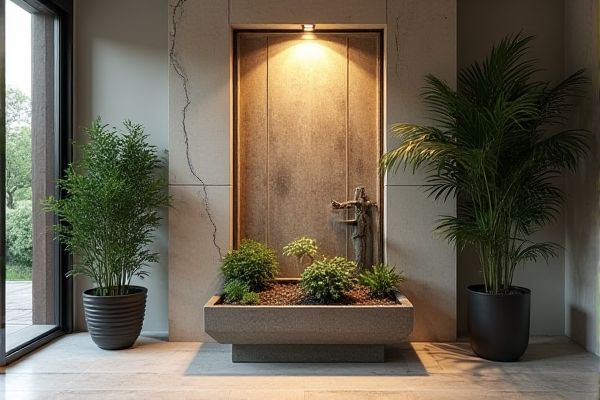
Tabletop fountains offer compact, portable water features perfect for small spaces or desks, providing soothing sounds and aesthetic appeal without installation, while wall fountains create a dramatic focal point by integrating water flow into vertical surfaces, ideal for gardens or patios. Discover which option suits Your space and lifestyle best by exploring the rest of this article.
Table of Comparison
| Feature | Tabletop Fountain | Wall Fountain |
|---|---|---|
| Installation | Portable, easy to set up on any flat surface | Requires mounting on a wall, more permanent |
| Size | Compact, ideal for small spaces | Larger, fits medium to large areas |
| Water Flow | Gentle trickling sound | Stronger water flow, variable sounds |
| Maintenance | Easy to clean and refill | Requires wall access for maintenance |
| Design & Style | Decorative, fits desktops and shelves | Architectural, enhances wall aesthetics |
| Power Source | Electric plug-in or battery operated | Usually electric, requires wiring |
| Cost | Generally lower priced | Moderate to high, depending on size and materials |
| Suitability | Indoor use, offices, homes | Indoor and outdoor, patios, gardens |
Introduction to Tabletop and Wall Fountains
Tabletop fountains are compact water features designed for indoor use, providing soothing water sounds and decorative appeal on desks or shelves. Wall fountains are mounted vertically on walls, offering a space-saving and visually striking water display ideal for both indoor and outdoor environments. Each fountain type contributes to ambiance enhancement through unique installation styles and water flow dynamics.
Space Requirements: Tabletop vs Wall Fountains
Tabletop fountains require minimal floor space, making them ideal for desks, shelves, or small tables, perfect for compact areas or office environments. Wall fountains save valuable floor space by mounting directly on a wall, suitable for both indoor and outdoor settings where surface area is limited. Your choice depends on the available space and desired decorative impact, with tabletop fountains fitting small spaces and wall fountains enhancing vertical areas.
Installation Process Comparison
Tabletop fountains offer a simple installation process, often requiring only placement on a flat surface and connection to a power source, making them ideal for quick setup in small spaces. Wall fountains demand a more involved installation, including wall mounting, securing brackets, and plumbing connections for water circulation, which typically requires professional assistance. The ease of installation makes tabletop fountains more accessible for renters or those seeking portability, while wall fountains provide a permanent, decorative feature with higher installation complexity.
Design and Aesthetic Options
Tabletop fountains offer compact, portable designs with a variety of styles ranging from modern minimalism to natural stone aesthetics, making them ideal for desktops or small spaces. Wall fountains provide larger, more dramatic visual impact with intricate mosaics, carved stone, and customizable water flow patterns that serve as statement pieces in gardens or patios. Your choice depends on the desired scale and ambiance, with tabletop fountains enhancing intimate environments and wall fountains transforming outdoor or indoor walls into artistic water features.
Maintenance and Cleaning Differences
Tabletop fountains require minimal maintenance, typically involving regular water refills and occasional cleaning of the pump and basin to prevent algae buildup. Wall fountains often demand more intensive upkeep due to their larger water reservoirs and intricate plumbing, necessitating periodic inspections to avoid leaks and mineral deposits. Proper maintenance routines ensure longevity and optimal performance for both fountain types.
Water Flow and Sound Characteristics
Tabletop fountains feature gentle water flow that creates soft, soothing sounds ideal for small spaces and personal relaxation. Wall fountains typically have a stronger, cascading water flow that produces more pronounced soundscapes, enhancing ambient noise in larger areas. Your choice depends on the desired intensity of water movement and auditory ambiance.
Cost Analysis: Initial and Ongoing Expenses
Tabletop fountains typically involve lower initial costs, ranging from $30 to $150, with minimal installation expenses, making them budget-friendly for small spaces. Wall fountains, on the other hand, often require professional installation and plumbing, which can push initial costs to $300 or more, plus higher ongoing maintenance and electricity expenses. Your choice should consider not only upfront affordability but also long-term costs associated with upkeep and energy consumption.
Suitability for Indoor and Outdoor Settings
Tabletop fountains are highly suitable for indoor settings due to their compact size and ease of placement on desks, shelves, or countertops, providing soothing water sounds without requiring extensive installation. Wall fountains excel in both indoor and outdoor environments, offering decorative and functional benefits with their larger design, often installed on exterior walls or spacious indoor areas to enhance ambiance. While tabletop fountains prioritize portability and convenience indoors, wall fountains demand more space and installation but contribute significantly to outdoor landscaping and interior focal points.
Impact on Ambiance and Air Quality
Tabletop fountains create a soothing ambiance with gentle water sounds that enhance relaxation and improve indoor air quality by adding subtle humidity, making your space feel fresher. Wall fountains provide a dramatic visual impact with cascading water, doubling as a dynamic decor piece while also contributing to air purification through natural moisture dispersion. Choosing between them depends on the desired balance between aesthetic presence and localized air quality improvement.
Which Fountain Type Is Right for You?
Choosing between a tabletop fountain and a wall fountain depends on your available space and design preferences. Tabletop fountains offer portability and fit well in small areas, making them ideal for desks or shelves, while wall fountains create a striking vertical feature perfect for patios or garden walls. Consider your space constraints and aesthetic goals to determine which fountain type complements your environment and lifestyle best.
 homyna.com
homyna.com